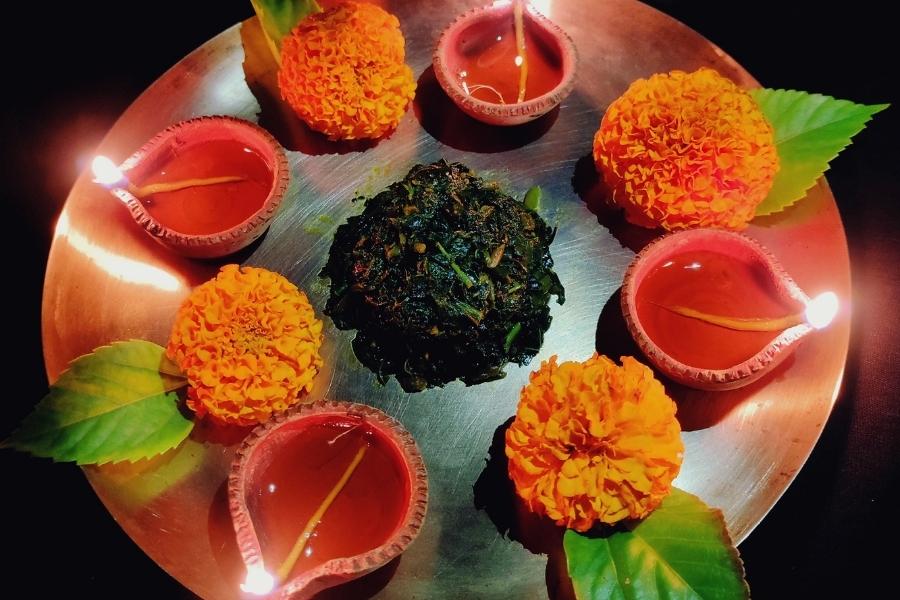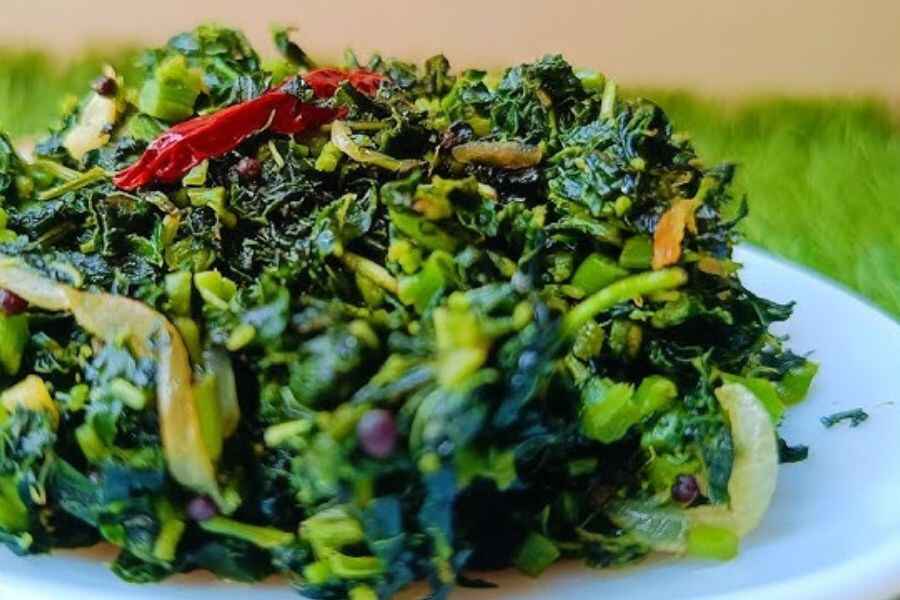On the eve of Kali Puja, as the city explodes with the sound of crackers and the glow of oil lamps, Bengali kitchens turn to something quieter — a pot of greens simmering on the stove. This is Choddo Shaak, a traditional medley of 14 leafy vegetables that has been part of Bengali ritual and memory for generations.
Eaten on Bhoot Chaturdashi, a day believed to protect homes from evil spirits, the dish is steeped in symbolism. Each leaf, from the common spinach to the elusive ‘shushni’, is said to guard the body and spirit against harm. The practice of cooking Choddo Shaak, along with lighting 14 earthen lamps or ‘choddo pradip’, connects the living with the ancestors and marks a moment of cleansing before the grand festival of Kali Puja.
“Bengali families observe a special tradition of cooking Choddo Shaak on this day,” said Debjani Chatterjee Alam, food blogger. “Each of these greens symbolises different aspects of life and the world around us.” Cooked without onion or garlic, the dish is a gentle reminder that simplicity and reverence often go hand in hand.
The 14 greens

The mix of greens varies slightly from home to home and is also tied to availability. Traditionally, it includes Brahmi (water hyssop), Helencha (buffalo spinach), Kulekhara (swampweed), Laal Shaak (red amaranth), Lau Shaak (bottle gourd leaves), Methi (fenugreek), Mulo Shaak (radish leaves), Pui Shaak (Malabar spinach), Palong (spinach), Potol Shaak (pointed gourd leaves), Punarnava (wild hogweed), Shorshe (mustard greens), Shaluk (water-lily leaves) and Shushni (sicklepod).
Chatterjee noted that this dish is “not only a vegetarian dish, but also a vegan Bengali delicacy,” celebrating purity and simplicity while being deeply rooted in ritual.
Nutritional significance
According to Payel Kr Roy, HOD of Dietetics Dept & Critical Care Nutritionist at Techno India DAMA Multispeciality Hospital, the practice of eating Choddo Shaak on Bhoot Chaturdashi is far more than ritual — it is seasonal wisdom passed down through generations.
“This dish brings together 14 leafy vegetables that are naturally rich in antioxidants, vitamins, minerals and fibre. At the onset of winter, when immunity drops, these greens help the body fight infections and cleanse it from within,” she says. The combination of plants supports digestion and gut health, which in turn strengthens overall immunity.
Roy adds that many of the greens have anti-inflammatory and antihistamine properties, making them beneficial for allergies, skin health and respiratory wellness during changing weather. “Choddo Shaak is like nature’s preventive medicine,” she says. Rooted in Ayurvedic principles, the ritual aligns perfectly with the body’s seasonal needs, blending tradition, nutrition and healing in one comforting bowl.
Beyond tradition, Choddo Shaak is packed with health benefits. “Leafy greens are beneficial for health. They are packed with antioxidants, vitamins, minerals, iron and other essential nutrients,” said Debjani. Many of these greens aid digestion, boost immunity and act as natural detoxifiers — making the dish a timely seasonal cleanser after Durga Puja’s indulgence.
Recipe for Choddo Shaak
Ingredients
- Brahmi (water hyssop): a handful
- Helencha (buffalo spinach): a handful
- Kulekhara (swampweed): a handful
- Laal Shaak (red amaranth): a handful
- Lau Shaak (bottle gourd leaves): a handful
- Methi (fenugreek leaves): a handful
- Mulo Shaak (radish leaves): a handful
- Pui Shaak (Malabar spinach): a handful
- Palong Shaak (spinach): a handful
- Potol Shaak (pointed gourd leaves): a handful
- Punarnava: a handful
- Shorshe Shaak (mustard greens): a handful
- Shaluk Shaak (water-lily leaves): a handful
- Shushni Shaak (sicklepod): a handful
- Mustard oil: 1 tablespoon
- Dried red chilli: 1
- Panch phoron: ¼ teaspoon
- Turmeric powder: 1 teaspoon
- Salt: to taste
- Sugar: 1 teaspoon (optional)
Method
• Clean and wash all the greens thoroughly and chop them roughly.
• Heat mustard oil in a pan.
• Add ‘panch phoron’ and the dried red chilli to the hot oil and let them crackle.
• Add all the chopped greens and stir well.
• Mix in turmeric powder and salt, then cook on low flame.
• The greens will release water; let them cook in their own juices until soft.
• Stir occasionally to prevent sticking.
• Add a pinch of sugar if desired and adjust the seasoning.
• Serve hot with steamed rice.
As Debjani puts it, “This is one of those dishes that connects food to faith and memory — cooked once a year, but remembered year-round.”
